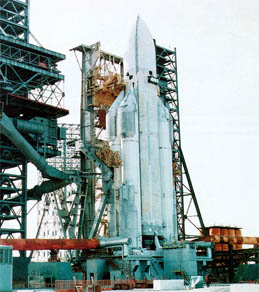History
In May, 1974 the N1 rocket program is stopped. Mishine is fired by the direction of the study office of OKB-1. A new organization, Energia NPO, is created, directed by the former colleague of Korolev (Glushko), it groups together the 2 research departments of Glushko and Korolev. Although the Soviet citizens spent more than 2.4 billion roubles in the Lunar project they were still far from having a heavy functioning launcher. All the work on the N1 launcher was destroyed and Glushko and Yangel OKB began the development of the Vulkan launcher from scratch. This enormous launcher had to put into orbit elements elaborated for the lunar program LEK (Lunar Expedition Complex).
This new launcher was modified on February 17th, 1976 when Glushko had to take into account the new specifications for the Buran shuttle. These changes led to move the payload from the nose cone to the side of the launcher, and to modify the structure of the boosters around of the central block, as well as other numerous modifications. The Energia launcher was born.
Purpose of the Energia LV
The Energia launcher was not only intended for lifting the Buran space shuttle but to carry different kind of payloads. That's why the main engines are not located on the shuttle. For its first maiden flight it carried the space combat station Polyus on its side. The configuration for the payload for on its side, so it could carry up to 100 tons in LEO, and 32 tons for the Moon and Mars.

On the Soviet side, the advent of the system is directly related to the demise the N1 Moon rocket in the early From 1969 to 1972, four consecutive launch of the N1 failed. The Soviet government cancelled this program in favor of the heavy lift vehicle called Energiya. The government this new project to the Energiya Scientific Organization (NPO Energiya).43 Interestingly enough, one significant who worked on both the N1 and Energiya was Boris Gubanov, who worked on former in its infancy and then served Chief Designer of the Energiya rocket twenty later.
In May 1974, a large shake-up of the space program took place which led to Buran half of the project. Vasiliy Mishin, was the chief designer at the influential design bureau, was unceremoniously fired while he in the hospital. TsKBEM merged with Valentin KB EnergoMash bureau to form the powerful Energiya Scientific Production Organization (NPO Energiya). Glushko took over this huge new organization, supervising all Soviet human spacecraft, launch vehicles, and satellites. Famed Soviet rocketry pioneer Sergei Korolev founded the seed of NPO Energiya, but Glushko had even more power. As one his first official acts, the vindictive Glushko an order suspending all work on the and associated lunar projects. In a single Glushko had cancelled Mishin's grand plans for exploration.

